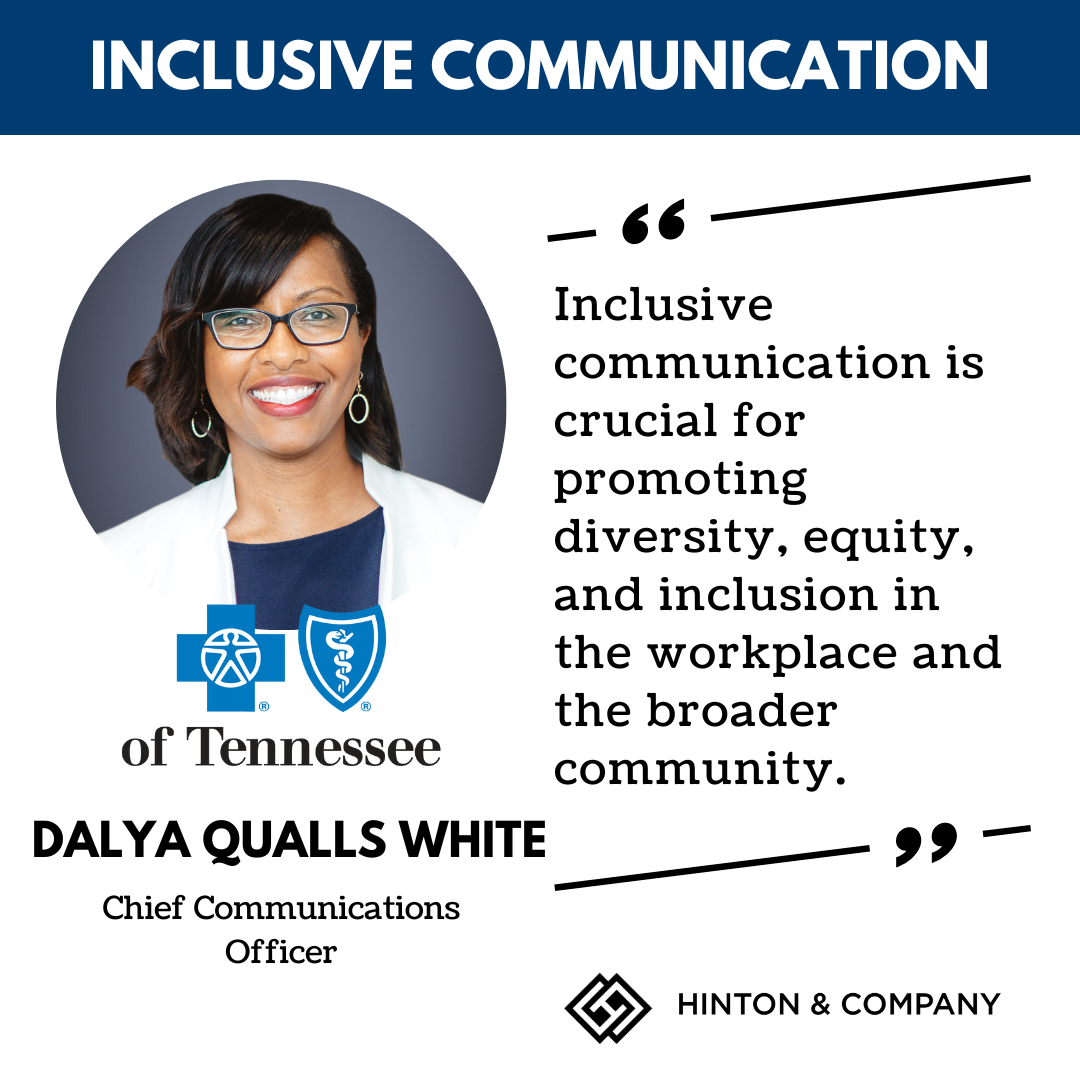Creating Inclusive Communication: Insights from BlueCross BlueShield of Tennessee's Chief Communications Officer
Dalya Qualls White, SVP and Chief Communications Officer at BlueCross BlueShield of Tennessee (BCBST)
Inclusive communication is more than just using the right words and phrases. It's about making sure everyone feels respected, valued, and a part of the team. At BlueCross BlueShield of Tennessee (BCBST), inclusive communication is a critical part of their business operations, both in terms of serving their members and in their recruitment and retention efforts.
We recently sat down with Dalya Qualls White, SVP and Chief Communications Officer at BCBST, to discuss her approach to creating inclusive communications. She shared how they measure the impact of their inclusive communication efforts and respond to communications related to diversity and inclusivity. The strategies and insights shared can serve as a valuable guide for any organization looking to further advance along their inclusion journey.
A few key takeaways:
Inclusive communication is critical for focusing on diversity, equity, and inclusion in the workplace and the broader community.
Strategies for inclusive communication include making digital materials accessible, using inclusive language, showcasing diversity in visuals and member/employee profiles, and measuring the impact of these efforts.
To help avoid implicit biases and stereotypes, organizations can provide training to their communication staff and create an inclusive language guide.
We invite you to read the full interview below.
How do you define inclusive communications? Inclusive communications are critical to our business operations, both in terms of serving our members and in our recruitment and retention efforts. We're thoughtful and intentional about how we communicate, and we work to ensure everyone feels respected and valued, and most importantly, like they are part of the team, whether BlueCross BlueShield of Tennessee is their insurer or their employer. To me it means using appropriate words and phrases that allow people to identify with what you're saying and see themselves in the collective. I think it's also important to note that inclusive communications are not static. They require a degree of learning and flexibility, as well as a willingness to adapt as language and expectations change.
What steps do you take to ensure that your communications are inclusive and representative of diverse perspectives and communities and how other organizations can adopt similar strategies? We do this on several fronts. From a practical perspective, we're working to make sure our external website and all digital materials are accessible for visitors with visual and hearing impairments. This effort is being led by an employee on our digital marketing team who has a vision impairment. She's also participated in an external-facing feature story to help teach others how to effectively and respectfully communicate with those who are visually impaired. Another step we take in our inclusive communication is to make sure all of our video content is closed captioned, and we make sure that high quality transcripts are available for download, which has become increasingly important in today's virtual environment. In addition to using inclusive language, we make sure that the visuals in our materials are representative of all the communities we serve and the people who work for us. We strive to showcase diversity of all types, including age, race, gender, orientation, and abilities. This approach also guides us as we create member and employee profiles for our external-facing newsletters and social media. I mentioned intentionality earlier, and I think that's key for other organizations interested in adopting a similar strategy. At BlueCross, we are intentional in all things related to diversity and inclusion. And when you set a goal and hold yourself accountable to it, I think you're encouraged to take action.
How do you measure the impact of your inclusive communication efforts? We start with what's important to the business. Are we continuing to attract and sell health plans to a diverse customer base? And every year we ask our employees to participate in an engagement survey that measures how they feel about working at BlueCross, and that includes questions related to inclusion. We also host four cultural awareness sessions each year that allow employees to share about their own backgrounds and build understanding, and we measure participation and engagement in those events. We’ve started conversations and provided valuable insights with the launch of our first-ever Health Equity Report. Finally, we're always listening to employees and taking their personal feedback into consideration as our work evolves.
How have recent social and cultural movements impacted how your organization communicates with its stakeholders? BlueCross has been focused on diversity and inclusion for many, many years, and that commitment starts at the top. Like other organizations, the summer of 2020 was a time when we became even more intentional and put additional effort into listening to one another and building more understanding of the different perspectives in our workplace.
Can you discuss your approach to responding to communications crises related to diversity or inclusivity? Any situation we're communicating about is related to diversity and inclusion because it's related to people. Our employees come from all different backgrounds and so do our customers, so we use that understanding as a lens.
How do you train your communications staff to recognize and avoid implicit biases and stereotypes in their messaging? We're diligent about ensuring our communication standards and best practices evolve and stay up to date, particularly as it relates to diversity. As an example, our member communications, diversity and inclusion, and corporate communications teams are working together on an inclusive language guide to make sure we are welcoming in our interactions and communications. Our diversity and inclusion team has also created specific training around relevant topics, including unconscious bias. All of our employees, including our communications staff, have participated in this required training.
Interested in unlocking the power of inclusive communication? Contact us today to learn more about how we can help your organization create a culture of belonging. Let's get started!

